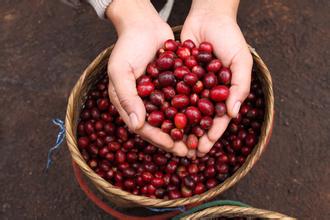The birthplace of coffee culture: is it better to import coffee beans from Laos after baking or raw coffee beans?
Coffee Culture-birthplace
In ancient China, Shennong tasted all kinds of herbs and recorded them one by one, so that later generations could have a systematic understanding of many plants. There is no such person as Shennong in the western world, let alone any written record, so there are different legends about the origin of coffee. Among them, the most common and popular story is the story of the shepherd.
In ancient times, Arabs first dried and boiled coffee beans and drank the juice as stomach medicine, thinking that it could help digestion. Later, it was found that coffee also had a refreshing effect, and because Muslims strictly prohibited drinking, coffee was used instead of alcoholic beverages as a refreshing drink. After the 15th century, Muslims who made pilgrimages to the holy land of Mecca brought coffee back to their places of residence, and coffee gradually spread to Egypt, Syria, Iran, Turkey and other countries. The entry of coffee into Europe should be attributed to the Ottoman Empire of Turkey at that time. Because the coffee-loving Ottoman army marched westward to Europe and was stationed there for several years, when the army finally withdrew, it left a large number of supplies, including coffee beans. People in Vienna and Paris were able to develop European coffee culture based on these coffee beans and the cooking experience gained from the Turks. The war was originally occupied and destroyed, but it unexpectedly brought about cultural exchange and even integration, which was unexpected by the rulers.
Westerners are familiar with coffee with a history of three hundred years, but in the East, coffee has been widely used as a drink in all walks of life in the East. Coffee appeared earliest and most accurately in the 8th century BC, but as early as Homer's works and in many ancient Arab legends, a magical, dark, bitter, and highly stimulating drink has been recorded. Around the 10th century AD, Avicenna,980-1037 was using coffee as a medicine to treat diseases. There is also a strange story from the 15th century in which it is said that a Yemeni shepherd saw a group of goats picking reddish berries from a bush. Soon the goats became restless and excited. The shepherd reported this to a monk, who cooked some berries. Then extract a bitter, strong drink that can drive away drowsiness and drowsiness.
Although coffee was found in the Middle East, coffee trees first originated in Africa, a region now belonging to Ethiopia, called Kaffa, from which coffee spread to Yemen, Arabian Peninsula and Egypt, where coffee developed rapidly and soon became popular in people's daily lives. By the 16th century, early merchants had sold coffee in Europe, thus introducing coffee as a new drink into Western customs and life. The vast majority of coffee exported to the European market comes from Alexandria and Smyrna, but with growing demand and high tariffs imposed by import and export ports, as well as increased knowledge of coffee planting, dealers and scientists are experimenting with transplanting coffee to other countries. The Dutch planted coffee trees in their overseas colonies (Batavia and Java), and the French in Martinique (in Latin America) in 1723, and then in the Antilles. Later, the British, Spaniards and Portuguese began to invade the tropical coffee-growing areas of Asia and America.
Coffee cultivation began in northern Brazil in 1727, but poor weather conditions gradually shifted the crop to other regions, first in Rio de Janeiro, and finally to Sao Paulo and Minas (circa 1800-1850). Here coffee found its ideal growing environment. Coffee cultivation grew here until it became Brazil's most important source of economy. It was between 1740 and 1850 that coffee cultivation reached its highest popularity in Central and South America. Although coffee was born in Africa, cultivation and household consumption were introduced relatively recently. In fact, it was the Europeans who brought coffee back to its homeland and introduced it into their colonies, where it flourished because of favorable land and climatic conditions.

Important Notice :
前街咖啡 FrontStreet Coffee has moved to new addredd:
FrontStreet Coffee Address: 315,Donghua East Road,GuangZhou
Tel:020 38364473
- Prev

After baking a jin of coffee and raw beans in Elsa Coffee Manor
Workers at Elsa Coffee Manor, located in the western valley of Costa Rica, are no longer as busy as coffee harvest in May and June, and their work is focused on shelling and screening of raw beans before export. In recent years, the manor began to follow the development route of boutique coffee. Coffee raw beans have won prizes in COE boutique coffee competitions many times, and their coffee has been in the international community.
- Next

Taste characteristics of Guatemala coffee Coffee bean washing
Guatemala Antigua coffee flavor characteristics: rich, rich taste, with tobacco flavor. The palate is soft and mellow with a hint of charcoal, just like the sweetness of chocolate mixed with smoke. Antigua coffee is also known as Cigarette Coffee because of its unique charcoal-burning aroma. The main areas of Guatemala producing quality coffee are Lake Atitlan and Veve
Related
- Does Rose Summer choose Blue, Green or Red? Detailed explanation of Rose Summer Coffee plots and Classification in Panamanian Jade Manor
- What is the difference between the origin, producing area, processing plant, cooperative and manor of coffee beans?
- How fine does the espresso powder fit? how to grind the espresso?
- Sca coffee roasting degree color card coffee roasting degree 8 roasting color values what do you mean?
- The practice of lattes: how to make lattes at home
- Introduction to Indonesian Fine Coffee beans-- Java Coffee producing area of Indonesian Arabica Coffee
- How much will the flavor of light and medium roasted rose summer be expressed? What baking level is rose summer suitable for?
- Introduction to the characteristics of washing, sun-drying or wet-planing coffee commonly used in Mantenin, Indonesia
- Price characteristics of Arabica Coffee Bean Starbucks introduction to Manning Coffee Bean Taste producing area Variety Manor
- What is the authentic Yega flavor? What are the flavor characteristics of the really excellent Yejasuffi coffee beans?

